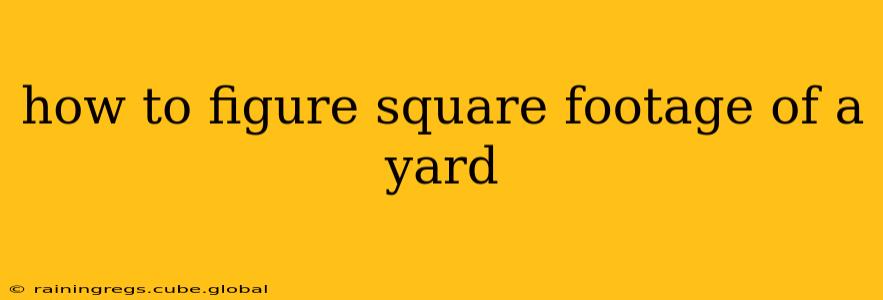Knowing your yard's square footage is crucial for various reasons, from determining the amount of fertilizer needed to planning landscaping projects or installing a new patio. While it might seem daunting, calculating your yard's square footage is relatively straightforward, and this guide will walk you through several methods.
What is Square Footage?
Square footage is simply the area of a space measured in square feet (ft²). One square foot is a square with sides measuring one foot each. To find the square footage, you're essentially determining how many of these one-foot squares would fit within your yard's boundaries.
Method 1: Measuring a Rectangular or Square Yard
This is the easiest method for yards with a simple rectangular or square shape.
- Measure the length: Use a measuring tape to measure the longest side of your yard. Record this measurement in feet.
- Measure the width: Measure the shortest side of your yard, perpendicular to the length. Record this measurement in feet.
- Calculate the area: Multiply the length by the width. The result is your yard's square footage.
Example: Length = 50 feet, Width = 30 feet. Square footage = 50 feet x 30 feet = 1500 square feet.
How to handle irregular shapes within a rectangular yard?
If your yard is mostly rectangular but has small irregular sections (like a curved flowerbed), you can estimate. Either approximate the area of the irregular sections and subtract it from the total rectangular area or, for more accuracy, break the irregular parts down into smaller shapes (like triangles or circles) and calculate their individual areas before subtracting from the main rectangular area.
Method 2: Measuring an Irregularly Shaped Yard
For yards with complex shapes, the process is slightly more involved. You'll likely need to divide your yard into smaller, more manageable shapes (rectangles, triangles, etc.).
- Divide and conquer: Break down your yard into several smaller, simpler shapes. Sketch a rough diagram of your yard, labeling each section.
- Measure each section: Measure the length and width (or relevant dimensions for other shapes like triangles – base and height) of each section individually.
- Calculate the area of each section: Use the appropriate formula for each shape (rectangle: length x width; triangle: 0.5 x base x height; circle: π x radius²).
- Add up the areas: Sum the areas of all the individual sections to get the total square footage of your yard.
Method 3: Using Online Calculators
Many free online calculators can help you determine your yard's square footage. Simply input your measurements, and the calculator will do the math for you. These are helpful, particularly for complex shapes. Search for "yard square footage calculator" on your preferred search engine.
Method 4: Using a GPS-Enabled Measuring Tool
Modern smartphone apps and specialized GPS-enabled devices can measure area fairly accurately. These apps often allow you to walk the perimeter of your yard, and the app will automatically calculate the area. Ensure that you maintain a consistent distance from the boundaries to obtain the most accurate results.
How to Account for Obstacles?
Things like houses, sheds, driveways, and pools reduce your usable yard space. To calculate the usable square footage, follow these steps:
- Calculate the total square footage: Use one of the methods above to determine the total square footage of your entire property.
- Calculate the square footage of obstacles: Measure the length and width of each obstacle and calculate its area.
- Subtract the obstacle area: Subtract the total area of all obstacles from the total square footage of your property to find the usable square footage.
Frequently Asked Questions (FAQs)
How accurate do I need to be when measuring my yard?
For most purposes, a reasonably accurate measurement is sufficient. Small errors in measurement will have a minimal impact on the overall square footage. However, if you are purchasing materials based on the calculated square footage, it is better to overestimate slightly.
What if my yard has curves?
For curved areas, approximate them using simpler shapes as closely as possible. Breaking down curves into smaller segments and treating each segment as a triangle or trapezoid can greatly improve accuracy.
Can I use a measuring wheel to measure my yard?
Yes, a measuring wheel is a great tool for efficiently measuring larger areas, especially for longer, straight sections.
By following these steps and choosing the appropriate method for your yard's shape, you can accurately determine its square footage for all your landscaping and yard work needs. Remember to always double-check your measurements for the most accurate results.
